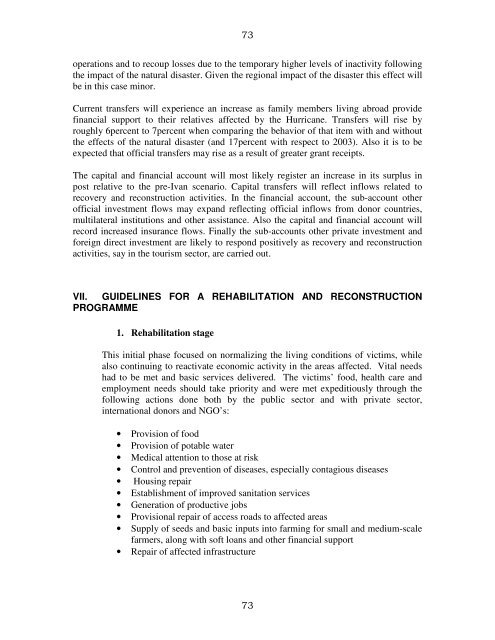Jamaica: Macro-Socio-Economic and Environmental Assessment of ...
Jamaica: Macro-Socio-Economic and Environmental Assessment of ...
Jamaica: Macro-Socio-Economic and Environmental Assessment of ...
You also want an ePaper? Increase the reach of your titles
YUMPU automatically turns print PDFs into web optimized ePapers that Google loves.
73<br />
operations <strong>and</strong> to recoup losses due to the temporary higher levels <strong>of</strong> inactivity following<br />
the impact <strong>of</strong> the natural disaster. Given the regional impact <strong>of</strong> the disaster this effect will<br />
be in this case minor.<br />
Current transfers will experience an increase as family members living abroad provide<br />
financial support to their relatives affected by the Hurricane. Transfers will rise by<br />
roughly 6percent to 7percent when comparing the behavior <strong>of</strong> that item with <strong>and</strong> without<br />
the effects <strong>of</strong> the natural disaster (<strong>and</strong> 17percent with respect to 2003). Also it is to be<br />
expected that <strong>of</strong>ficial transfers may rise as a result <strong>of</strong> greater grant receipts.<br />
The capital <strong>and</strong> financial account will most likely register an increase in its surplus in<br />
post relative to the pre-Ivan scenario. Capital transfers will reflect inflows related to<br />
recovery <strong>and</strong> reconstruction activities. In the financial account, the sub-account other<br />
<strong>of</strong>ficial investment flows may exp<strong>and</strong> reflecting <strong>of</strong>ficial inflows from donor countries,<br />
multilateral institutions <strong>and</strong> other assistance. Also the capital <strong>and</strong> financial account will<br />
record increased insurance flows. Finally the sub-accounts other private investment <strong>and</strong><br />
foreign direct investment are likely to respond positively as recovery <strong>and</strong> reconstruction<br />
activities, say in the tourism sector, are carried out.<br />
VII. GUIDELINES FOR A REHABILITATION AND RECONSTRUCTION<br />
PROGRAMME<br />
1. Rehabilitation stage<br />
This initial phase focused on normalizing the living conditions <strong>of</strong> victims, while<br />
also continuing to reactivate economic activity in the areas affected. Vital needs<br />
had to be met <strong>and</strong> basic services delivered. The victims’ food, health care <strong>and</strong><br />
employment needs should take priority <strong>and</strong> were met expeditiously through the<br />
following actions done both by the public sector <strong>and</strong> with private sector,<br />
international donors <strong>and</strong> NGO’s:<br />
• Provision <strong>of</strong> food<br />
• Provision <strong>of</strong> potable water<br />
• Medical attention to those at risk<br />
• Control <strong>and</strong> prevention <strong>of</strong> diseases, especially contagious diseases<br />
• Housing repair<br />
• Establishment <strong>of</strong> improved sanitation services<br />
• Generation <strong>of</strong> productive jobs<br />
• Provisional repair <strong>of</strong> access roads to affected areas<br />
• Supply <strong>of</strong> seeds <strong>and</strong> basic inputs into farming for small <strong>and</strong> medium-scale<br />
farmers, along with s<strong>of</strong>t loans <strong>and</strong> other financial support<br />
• Repair <strong>of</strong> affected infrastructure<br />
73
















